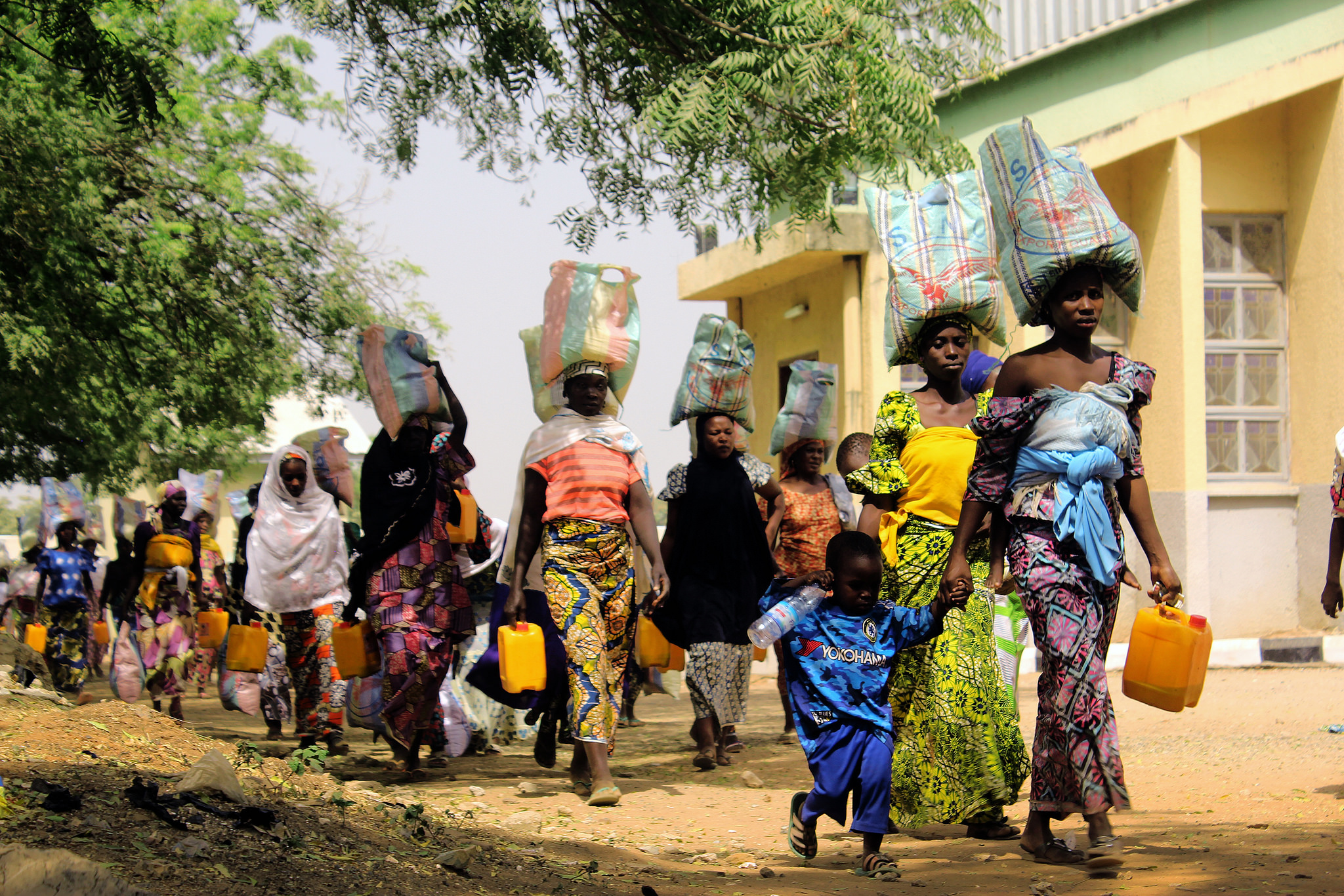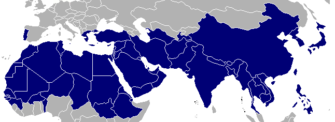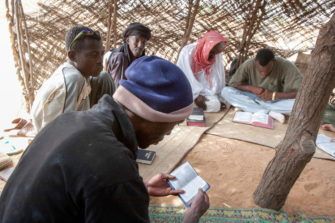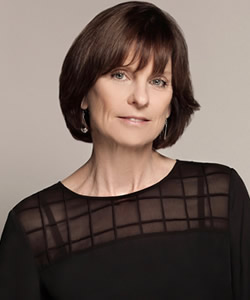
This statement seems to me to be both obviously right and obviously wrong, and I am interested in this fact. I would like to think through the intersections of race, civilization, and religion, looking specifically at one case of Christian-Muslim encounter and conflict in Africa.
The idea that anti-Muslim sentiment is a kind of racism has been an important intervention in the discourse about Islamophobia. The most obvious example is the Islamophobia is racism syllabus (to which I contributed), which seeks to expose “the intersection of race and religion as a reality of structural inequality and violence rooted in the longer history of US (and European) empire building.” Syllabus contributors and other scholars aim to show that anti-Muslim-ism is a project, one rooted in structures of power, developed in the context of colonialism, and organized around a logic that is both geographical and racialized. Racial discourse in the United States has in effect constructed a “Middle Eastern” racial category that is deeply linked to a vision, however inaccurate, of where Muslims are from: Muslims from the Middle East are included, as are non-Muslims from the Middle East, and non-Middle Eastern people from Pakistan or Afghanistan, along with a number of others, in the making of a form of racialized identity that draws on the history of Orientalism as well as anti-Arab racism and the intensification of anti-Muslim sentiment after September 11, 2001.1

Thanks in part to the work of people involved in the Contending Modernities Reexamining Religion and Modernities working group, we also have a great deal of excellent scholarship that shows how deeply US and European anti-Muslim sentiment is tied to the history of colonialism. This scholarship, along with the highly racialized speech of many anti-Muslim crusaders in recent years, makes the links clear. As Santiago Slabodsky shows us in Decolonial Judaism, the categories of religion and race have often intersected and informed each other, from the earliest structures of Orientalism to the most vicious logics of anti-Jewish racism. The history of the civilization/barbarism divide shows exactly how religion and race can be coproduced through the category of civilization and its others. I agree. I argue in Epic Encounters that anti-Muslim sentiment in the US is deeply linked to the history of US empire. And President Trump seems intent on further racializing Islam with the various versions of the Muslim ban, the most recent of which was upheld by the Supreme Court in June. Indeed, the very existence and widespread circulation of the argument that claimed President Obama was a Muslim was an extraordinary example of how racialization in in the form of anti-blackness could combine with Orientalist and post-9/11 forms of anti-Muslim sentiment.
So, why then make the contrary argument that anti-Muslim sentiment in the early 21st century does not work as a form of racism, at least not inevitably or consistently? What’s at stake and why insist on such parsing of forms of hostility? In making this argument I will draw on my own research on US and European evangelicals in their global encounters. I want to focus particularly on Islam in Africa, because in that context we can see how American and European evangelicals see people who they racialize as black to be differentiated by religion. Although African Muslims are represented by Christians in terms that are quite resonant with the terms of the civilization/barbarism divide, the discourse does a different, although not unrelated, kind of political mapping than that done by European or even US empire. Let me be clear about my intent: I do not want to suggest that racism is not central to the US discourse about Islam as it plays out in a domestic context or as it shapes foreign policy. There is clearly a racialized hostility toward people who are presumed to be “visibly Muslim and/or Arab and/or South Asian.” The incoherence of such a racial category matters not a bit to its real social force, and I am absolutely convinced that racial logic is almost always at work in the US context, even if I also believe there is a specific set of hostilities that is based on a notion that people who are Muslim are dangerous, no matter what their race. So I also want to argue that religious hostility is at work—that a primarily Christian (or Christian-derived) discourse about Islam has force in situations where the Muslims are not so easily distinguished from Christians by racialized language or assumptions.
Christian Evangelicals and Global Religious Competition
In my recently published book, The Kingdom of God Has No Borders, and in several articles over the last decade, I discuss in detail how demographic realities are shaping global Christianity. I term one response by US evangelicals “victim identification,” which calls for evangelicals to name and support those who are victimized. That victimization might be from poverty or political oppression, but it is frequently named as religious oppression. In particular, evangelicals are called to support “persecuted Christians” around the globe—particularly those who are said to be persecuted by Muslims.2

The discourse of Christians persecuted by Muslims has a long history, of course, and even among modern US evangelicals it can be traced back to at least the attack on Armenians in the Ottoman empire.3 But since the end of the Cold War, this logic has a new intensity in global evangelical life. It was in 1989 that evangelist Luis Bush declared at the second Lausanne Congress that it was time for evangelicals to “redeploy our missionaries” to concentrate on the vast area of “The 10/40 Window”—a region of the world that stretched from Africa to Asia, and from 10 degrees to 40 degrees north of the equator—a belt that included Northern and Central Africa, India, Pakistan, China, and all of the Middle East. Bush explained that the task of evangelizing the 10/40 Window was critical because it in these areas that Islam, Hinduism, and Buddhism “enslaved” the majority of their inhabitants and destroyed the lives of “billions of spiritually impoverished souls.” Islam in particular posed a challenge. From its center in the 10/40 Window, Islam was “reaching out energetically to all parts of the globe.”4
The 10/40 Window was embraced by evangelicals globally. And it shaped an incipient discourse in which the Cold War map of communism would be replaced with a global map that pitted Islam against Christianity. It might seem, in fact, that the idea of the 10/40 Window is a perfectly calibrated reworking of the great Orientalist binary, of a Christian West versus a Muslim East. And that was indeed a large part of its appeal. Yet, at the same time, while there were indeed regions mapped as “enslaved” by Islam (or Hinduism or Buddhism), the evangelical mapping of Africa in particular was far more nuanced. With African evangelicals taking a major role in the global evangelical community, and with African Christians so widely embraced and admired by at least some sections of the evangelical community in the US and Europe, countries where Muslims and Christians were in a complex contest for converts–places like Nigeria, Sudan, or Ethiopia—were not mapped as “enslaved.” Instead, US evangelical cultural producers perceived those regions as being both “us” and “not us”—simultaneously enchanting and threatening, occupied by (at least) two very different kinds of people, (black) Christians and (black) Muslims. (I will set aside the ways that evangelicals describe the dwindling population of followers of African Traditional Religions.)

As the twentieth century waned, the 10/40 Window and global Christian evangelism met newly missionary-minded forms of Islam in Africa. The da’wa movements of the late 20th century supported not only the propagation of the faith through teaching or publishing, but also hospitals and clinics, basic poverty relief, schools, and mosque building, with programs in all over the world, but particularly in Africa and parts of Asia. The practices of Christian missions clearly had an impact, as Muslims in places such as Tanzania and South Africa too began to hand out tracts, put stickers on cars, distribute cassettes, and invite foreign “revivalists” to preach.5
Christian Muslim Conflict and Global Discourse
American and European evangelicals played an undeniable role in shaping the struggle for believers in Africa. In 1991, for example, the faith-healing German evangelist Reinhard Bonnke traveled to preach in the Muslim-majority northern Nigerian state of Kano.6 In Nigeria, Bonnke was a familiar figure. A Pentecostal whose services often featured miraculous healings, denunciations of witchcraft, and the exorcism of demons, Bonnke had a strong following among a broad swath of Christians in Nigeria, including some Catholics and mainline Protestants who were searching for specific forms of “spiritual warfare” to fight disease or other dangers.7 Bonnke had visited Kano previously, in 1990, when he had preached to crowds that were, he claimed, one million people strong—each night. Bonnke was invited back a year later by the Kano state branch of the Christian Association of Nigeria. But Bonnke’s arrival in 1991 set off a riot. As many as 8,000 young Muslims gathered to meet his plane, their anger sparked by rumors of a negative comment that Bonnke was said to have made about Islam. (The government had also denied earlier requests for Kano to host a popular South African imam, Ahmed Deedat, and Louis Farrakan of the Nation of Islam.) Muslims marched into Christian Igbo neighborhoods and attacked residents; in response, Igbo youths marched with sticks, attacking Muslim shops and mosques. A number of people died in the riots; accounts vary from “several” to “hundreds.”8

Bonnke’s visit occurred during an already tense context: between the 1980s and early 2000s, there were at lease 48 religious riots in Nigeria.9 However, as scholars of Nigeria point out, defining the nature of the conflict is not always straightforward: in Nigeria as elsewhere, conflict that reads as religious is often fueled by other factors: neoliberal economic crises, ethnic tensions, anger at the corruption and inefficiency of the Nigerian government, etc.10 Certainly the fact that Kano is in the Muslim-identified North mattered, although there are Christians there as well. And so did the fact that most of the Christians who were attacked were Igbo, given that the Igbo were the group most identified with the break-away province of Biafra in the Nigeria-Biafra war of the late 1960s. Indeed, whether we see religious identification in Nigeria as primarily a result of colonial divide-and-rule strategies, or whether we follow Olufemi Vaughan in arguing that Muslim and Christian structures in Nigeria, forged by the two great globalizing religious movements of the nineteenth century, “made up the foundation on which the Nigerian colonial state was grafted,” there is no question that religious, ethnic, and regional identities are profoundly interconnected in Nigeria. There is no such thing as a “pure” religious identity—anywhere.
Still, it remains the case that, in Nigeria as in many other countries, religious identity is often a resource that ties (some parts of) diverse communities together, provides social solidarities and healing narratives, and offers alternatives to the despair that many feel in situations of profound economic injustice and inequality. Muslims and Christians both can draw on transnational ties to support projects and help construct identities that go beyond the local or national, and in those contexts, religious identities are meaningful beyond and in addition to ethnic or communal loyalties.11 Religious hostility is never purely about theology nor easily separable from other forms of social identity, but in such complex contexts, it is not just another form of ethnic politics either. The question of race is even more complicated, since racial formations in Nigeria are shaped by colonialism but reshaped by local contexts of nation, ethnicity, region, religion, and class. It just doesn’t make sense to say in Nigeria what Erik Love can credibly assert in the US context, that, “there are a set of physical traits and characteristics that can mark someone as ‘Muslim,’ regardless of their actual religion, ethnicity, or nationality. Race is the only way to explain how this is so.”12
Bonnke was banned from Nigeria after the riots. In the US, evangelical news outlets such as Christianity Today described the ban as the result of “anti-Christian government leaders” in Nigeria, rather than admitting the role Bonnke played in instigating violence. Indeed, heightened competition across Africa has led to a certain amount of hyperbole among evangelical commentators on Islam. For example, one 2004 document from the Lausanne Committee, a global evangelical organization, anxiously reported that “the movement of Christians into Islam, long familiar to churches living under Shariah conditions, is becoming a significant challenge for the whole church.”13 In reality, there was relatively little conversion from one faith to another at the time.14
The ongoing competition between Muslims and Christians, and the larger political environment, led Christians in particular to feel threatened. A 2010 poll found that, while most people in sub-Saharan Africa found religious tension to be a less pressing concern than unemployment, corruption, or crime, they nonetheless saw religious conflict as a “very big problem.” And Christians and Muslims often had negative views of each other. Although both sides had some positive images—seeing each other as devout, honest, and respectful of women—Christians in particular thought of Muslims as violent. And in some countries, a third or more of Christians reported that they believed that many or most Muslims were hostile toward Christians. Muslims felt the reverse in only a few places.15 Islam was viewed as a local threat in other parts of the world as well, but Africa was a key site of conflict, where local realities were shaped by a larger discourse—prevalent both in and beyond evangelical communities—that presented Islam as a global danger.

I have argued here that, in order to understand Christian-Muslim relations in Africa, we need to employ at least three lenses: a global racial/colonial perspective, an awareness of ethnic conflict, and a view of religious context that is at once local and global. (Other factors such as gender, class, or nationalism, or foreign policy are often also relevant.) The same is true if we want to appreciate the complex ways that race and religion intersect in US evangelical discourse about Africa. Many Americans are invested in a view of global Christianity as multiracial, transnational, liberalizing for women, and tolerant of others—in opposition to a vision of Muslims as multiracial, transnational, conservative on gender, and violently intolerant of others. Old models of binary racializing and imperialist discourse are present here, clearly, and yet the representation of Islam by American Christians is intertwined with, yet separate from, racial and regional mapping. The construction of a globalized Christian identity incorporates African Christians as “us” and African Muslims as dangerous; for Americans, the discourse of victim identification pits black Christian allies against Muslim others.
It is not the case, however, that Christians in Africa are presented by US evangelical discourse as being honorary whites. Certainly African Christians see themselves and are seen by Americans as “like us” in terms of religion, but American believers also construct Africans through the logic of enchanted internationalism—exotic, authentic, spirit-filled, and often idealized, if also implicitly coded as non-modern.
In this global context, to describe anti-Muslim discourse as (primarily) racism seems to me to flatten more than it explains. Imperialism and structural inequalities are highly relevant to the post-Cold War framing of Islam on a global scale and in Africa particularly, but neither race or “phobia” captures the full complexity of the power dynamics at play. In our transnational moment, we cannot simply export descriptions of how anti-Muslim sentiment works in the United States, even as we must continue to actively and insistently oppose the multiple forms of hostility and aggression faced by Muslims or those presumed to be Muslims in the US and beyond.
Featured Image: Sending Celebration at Grove Avenue Baptist Church in Richmond, Va. Photo Credit: International Mission Board, 2018.
[1] Erik Love, Islamophobia and Racism in America (New York: NYU Press, 2017); Khaled A. Beydoun, American Islamophobia: Understanding the Roots and Rise of Fear, First edition (Oakland, California: University of California Press, 2018); Deepa Kumar, Islamophobia and the Politics of Empire(Chicago: Haymarket Books, 2012); Nadia Marzouki, Islam: An American Religion, trans. C. Jon Delogu (New York: Columbia University Press, 2017); Kambiz GhaneaBassiri, “Islamophobia and American History: Religion, Stereotyping, and Out-Grouping of Muslims in the United States,” in Islamophobia in America: The Anatomy of Intolerance, 2013 edition (New York, NY: Palgrave Macmillan, 2013), 53–74.
[2] Melani McAlister, “What Is Your Heart For? Affect and Internationalism in the Evangelical Public Sphere,” American Literary History20, no. 4 (Winter 2008): 870–95; Melani McAlister, “US Evangelicals and the Politics of Slave Redemption as Religious Freedom in Sudan,” South Atlantic Quarterly113, no. 1 (Winter 2014): 87–108.
[3] Heather D. Curtis, Holy Humanitarians: American Evangelicals and Global Aid(Cambridge, Massachusetts: Harvard University Press, 2018); Ian Tyrrell, Reforming the World: The Creation of America’s Moral Empire(Princeton: Princeton University Press, 2010); Timothy Marr, The Cultural Roots of American Islamicism(New York: Cambridge University Press, 2006).
[4] The first elaboration of the concept is a 1990 paper that was published on the AD 2000 and Beyond website. This same essay is published in 1996: “Reaching the Core of the Core” Renewal Journal#10 (1997), http://www.pastornet.net.au/renewal/journal10/g-bush.htm. In subsequent years, the essay is reproduced on scores of web sites.
[5] David Westerlund and Ingvar Svanberg, Islam Outside the Arab World (Palgrave Macmillan, 1999), 97–125.
[6] Paul Gifford, “‘Africa Shall Be Saved’ : An Appraisal of Reinhard Bonnke’s Pan-African Crusade,” Journal of Religion in Africa 17, no. 1 (F 1987): 63–92.Westerlund and Svanberg, Islam Outside the Arab World, 97–125.On Islamic charity in the context of neoliberalism and changing roles of the state, see Mona Atia, Building a House in Heaven: Pious Neoliberalism and Islamic Charity in Egypt (Minneapolis: Univ Of Minnesota Press, 2013).
[7] Gifford, “Africa Shall Be Saved”; E E. Anugwom, “The Bonnke Effect: Encounters with Transnational Evangelism in Southeastern Nigeria,” in Religion Crossing Boundaries (Leiden: Brill, 2010), 211–17.
[8] Ogbu Kalu, African Pentecostalism: An Introduction(Oxford University Press, USA, 2008), 240; Muhib O. Opeloye, “The Socio-Political Factor in the Christian-Muslim Conflict in Nigeria,” Islam & Christian Muslim Relations 9, no. 2 (July 1998): 231.News accounts: “At Least 8 Dead in Nigerian City As Muslim-Christian Riots Go On,” NYT, October 17, 1991; Karl Maier, “Planned Christian Revival Sparks Riots in Nigeria,” Washington Post, October 20, 1991; “At Least 8 Dead in Nigerian City As Muslim-Christian Riots Go On,” New York Times, October 17, 1991.
[9] Matthews A. Ojo and Folaranmi T. Lateju, “Christian–Muslim Conflicts and Interfaith Bridge‐Building Efforts in Nigeria,” The Review of Faith & International Affairs8, no. 1 (January 1, 2010): 31–38.
[10] Ebenezer Obadare, Religion and Politics in Nigeria(S.l.: Zed Books Ltd, 2018); Ruth Marshall, Political Spiritualities: The Pentecostal Revolution in Nigeria(Chicago: University Of Chicago Press, 2009). See also Elizabeth Shakman Hurd, Beyond Religious Freedom: The New Global Politics of Religion (Princeton, NJ: Princeton University Press, 2015).
[11] Sharon E. Hutchinson, Nuer Dilemmas: Coping with Money, War, and the State(Berkeley, CA: University of California Press, 1996); Jean Comaroff and John L. Comaroff, Of Revelation and Revolution, Volume 1: Christianity, Colonialism, and Consciousness in South Africa, 1st ed., vol. 1, 2 vols. (University Of Chicago Press, 1991); James Howard Smith and Rosalind I. J. Hackett, eds., Displacing the State: Religion and Conflict in Neoliberal Africa (Notre Dame, Ind: University of Notre Dame Press, 2011).
[12] Love, Islamophobia and Racism in America, 2.
[13] Lausanne Committee, “LOP 49: Understanding Muslims” (Pattaya, Thailand: Lausanne Movement, 2004), 9, https://www.lausanne.org/content/lop/lop-49.The report is utterly vague about specifics, so it is impossible to tell which areas or regions it is talking about specifically. But given that there are few Christians in the Middle East, the most likely reference is sub-Saharan Africa.
[14] Pew Research Center, “The Future of World Religions: Population Growth Projections, 2010-2050” (Washington, DC: Religion and Public Life, April 2, 2015), 11, http://www.pewforum.org/2015/04/02/religious-projections-2010-2050/. Most of the projected increase in the Muslim population in sub-Saharan Africa is due to higher fertility rates among Muslims than Christians. This is true globally, where Muslims are expected to grow twice as fast as the overall population (p 70), and also in Africa, where the Muslim population was expected to increase from 30 percent to 35 percent by 2050.
[15] Luis Lugo and Alan Copperman, “Tolerance and Tension: Islam and Christianity in Sub-Saharan Africa” (Washington, DC: Pew Forum on Religion and Public Life, April 2010), 7–8, http://pewforum.org/executive-summary-islam-and-christianity-in-sub-saharan-africa.aspx.Sudan was not included in the survey. On how US policymakers perceived US policies as “secular” even as they were increasingly anti-Muslim, see Elizabeth Shakman Hurd, The Politics of Secularism in International Relations (Princeton, NJ: Princeton University Press, 2007).

